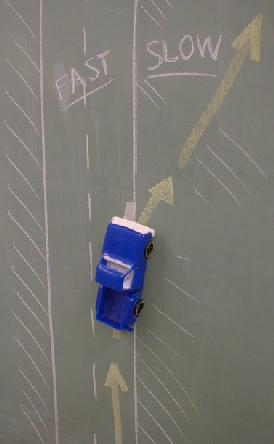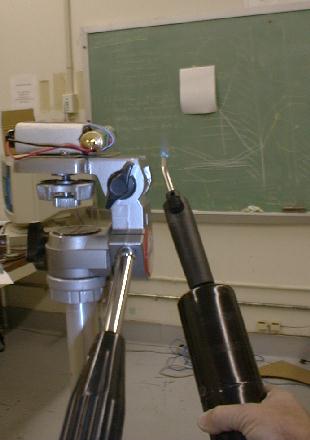 |
 | ||||||||||||
|
|||||||||||||

What is gravity?
Actually there were two questions, 'what is gravity' and 'why can't we feel the earth rotate?' I had brought a pair of magnets to show that the magnetic force acts between objects that have magnetic properties. It's important to make clear that the force is symmetric - the first object pulls on the second one with the same force that the second pulls on the first. Next I had two rocks. If I hold them close, do they attract each other? Yes!, but the force is so weak that I can't feel it. It takes a rock as big as the earth to pull on the one in my hand with a force that I can actually feel: gravity is an extremely weak force compared to magnetism. Next was the inverse-square law: if you weigh 100 pounds on the surface of the earth (that is, when the middle of your body and the middle of the earth are about 400 miles apart), then if that distance doubles, then the force decreases to 1/4th, and if the distance triples, the force decreases to 1/9th, quadruple -> 1/16th etc. This means that even if you go to the other end of the universe, the Earth still pulls on you, not very hard, but still... I brought in a prop that I had used before: a nylon screen-printing screen, with some big (smooth) rocks and small marbles and ballbearings. If you put a big rock on the screen (the earth), it makes a depression in the screen, and a marble placed elsewhere on the screen will roll toward the big rock. However, you can prevent the marble from falling onto the the Earth by making it go into orbit around it. This takes a little practice, but if you hit it right, you can get it to go around once or twice. Also, if you launch the ballbearing fast enough, it will fly right past, and only be deflected a little before going off into space again.
(...more text...)
|
|||||||||||||

Why do we see mirages?
This question has to do with refraction, when waves are bent when they go from a medium where they can go fast into a medium where they can only go slower (or the other way around). This happens to all sorts of waves, including light waves, ocean waves and sound waves. We talked about each of these, since they lead to phenomena that they can easily observe themselves.
That is, the direction of travel gets bent at the boundary between a fast medium (the concrete), and a slow medium (the grass).
Back to mirages: Imagine you stand on an asphalt road with a flashlight,
and you shine it forward and a little down. Normally, the light will go
straight till it hits the asphalt and is absorbed. But now imagine that
the sun is heating the road surface, and there is no wind. Then there
will be a thin layer of hot air sitting on the road. Now the light from
your flashlight will go from the cold air (thicker, slower) into the
hotter air (thinner, faster), and therefore it will be bent slightly upwards.
The difference in speed between the hot and cold air is not very great, so
the light can only be bent a small amount. But if the angle is very shallow,
and the temperature difference is sufficiently large, the light from your
flashlight will be bent up enough to go back up, just as if it bounced off
a mirror. Conversely, light from the sky near te horizon may be bent enough
to make it look as if it is reflected off the road. It looks like it is reflected
by water, but really it is refracted by a layer of hot air.
Links:
|
|||||||||||||

The Universe and all that
One question was 'What happens when you come to the end of the Universe?'. I asked the kids to imagine they lived in a small village, about a thousand years ago. Suppose someone had told them that the world is not infinitely big. The obvious first question would then be: if the world is not infinite, what will happen when you come to the end? Of course the answer in 1999 is that since the world is a sphere, it is not infinite, and yet you can go off in any direction, and never reach the end. In fact, you might come back, after traveling a long time, to the same village where you started, even if you were very careful to keep traveling in a straight line. All these things might have seemed mysterious and paradoxical to a 9th-century villager. The same model explains the concept of the 'horizon' of the observable universe: the world as known to the 9th-century villager consists of the local area, since that is all he has ever heard stories from. He's never heard any story from Mongolia. Mongolia is beyond the limits of his observable universe. His universe is maybe 50 miles in diameter. However, is he would travel to the edge of his universe, all of 50 miles, the landscape would likely look pretty much the same as around his own village. Our big universe is much the same. The universe that we can see, with telescopes of all kinds, is a finite place because light from further than about 13 billion light-years away has not reached us yet. This is our horizon of the observable universe. Also, if I could magically transport myself to a distant galaxy and look around, the universe would pretty much look the same as it does from here. It is even possible that if I fly off in some direction and take great care to keep on going straight, that I might come back to our own earth.
Links:
|
|||||||||||||
| |||||||||||||


